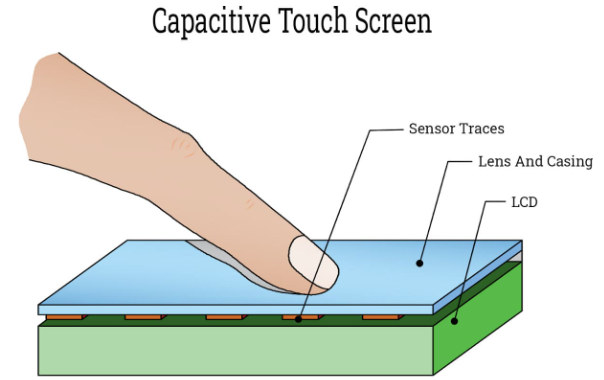The basic structure of an ordinary LCD display touch screen can be divided into three layers: protective layer, touch layer and display layer. There will be an air layer between the general protective glass, touch layer and display panel after bonding, because most LCD touch screens use frame bonding technology, and there will be an air layer between the touch screen and the LCD display. The full bonding technology removes the air layer, thereby reducing the thickness of the screen. The screen reflection is greatly reduced, the screen is thinner and more transparent, and it is more completely black when the screen is turned off, and it is still clearly visible under strong light.

Full lamination technology: Full lamination technology is to seamlessly bond the display panel and touch panel (or protective glass) together through optical glue (such as OCA or OCR).
Frame lamination technology: also known as mouth glue lamination, is to bond the display panel and touch panel together through frame glue strips (usually double-sided adhesive), leaving an air layer in the center of the panel.
What is the difference between touch screen full lamination process and frame lamination process?
Currently, the more powerful display panel manufacturers tend to promote the 0n-Cel or In-Cel solution, that is, they tend to make the touch layer on the display screen; while touch module manufacturers or upstream material manufacturers tend to prefer OGS, that is, making the touch layer on the protective glass.
(1) In-Cell
In-Cell refers to the method of embedding the touch panel function into the liquid crystal pixel, that is, embedding the touch sensor function inside the display screen, which can make the screen thinner and lighter. At the same time, the In-Cell screen must also be embedded with a matching touch IC, otherwise it is easy to cause erroneous touch sensing signals or excessive noise. The advantage of In-Cell technology is that it makes the display screen thin enough, and because the sensor conductive signal line is embedded in the LCD, it avoids circuit abnormalities caused by wear and tear, and has extremely high stability.
(2) On-Cell
On Cell refers to the method of embedding the touch screen between the color filter substrate and the polarizer of the display screen, that is, equipping the touch sensor on the liquid crystal panel, which is much easier than the In Cell technology.
(3) OGS
OGS technology is to integrate the touch screen with the protective glass, coat the TO conductive layer on the inside of the protective glass, and directly coat and photolithography on the protective glass. Since the OGS protective glass and the touch screen are integrated together, it usually needs to be strengthened first, then coated, etched, and finally cut. Such cutting on tempered glass is very troublesome, with high cost and low yield, and causes some capillary cracks to form on the edge of the glass, which reduces the strength of the glass.

In-Cell、On-Cell、OGSThe different structures of these three make the screen thinness, display effect, manufacturing cost, yield rate, etc. different, which are mainly reflected in the following points:
1. Screen transparency and visual effects: OGS is the best, followed by In-Cell and On-Cell. Therefore, whether it is In-Cell or On-Cell, the pure screen transparency and visual effect are actually not as good as some products using OGS screens.
2. Thinness: In-Cell is the lightest and thinnest, followed by OGS, and On-Cell is slightly worse than the first two.
3. Screen impact resistance and drop resistance: On-Cell is the best, OGS is the second, and In-Cell is the worst. It should be pointed out that since OGS integrates the cover glass with the touch layer, the processing weakens the strength of the glass and the screen is more fragile. It should also be pointed out that since In-Cell integrates the touch layer with the liquid crystal layer, once the touch screen has a problem, it must be replaced together with the display panel, which is very expensive.
4. Touch effect: OGS has the best touch sensitivity, followed by On-Cell, and In-Cell is the worst. However, high sensitivity is sometimes not a good thing. If the OGS process is not optimized, the ultra-high sensitivity can easily cause "screen jumping". Tiny dust, sweat, and water vapor can cause "misoperation" of the touch screen. In addition, because the In-Cell screen directly integrates the touch layer and the liquid crystal layer together, the sensing noise is relatively large, and a special touch chip is required for filtering and correction processing, while the OGS screen and On-Cell screen are not as dependent on the touch chip.
5. Technical requirements: In-Cell/On-Cell are more complex than OGS, with higher difficulty in production control and higher manufacturing costs.
6. Yield rate: At first, the yield rate of In-Cell screens was low, which greatly affected the supply of iPhone 5. However, as related manufacturers continued to increase their investment, the technology and process are now very mature. The yield rate of In-Cell screens is at the same level as On-Cell screens and OGS, and the yield rate has been greatly improved.